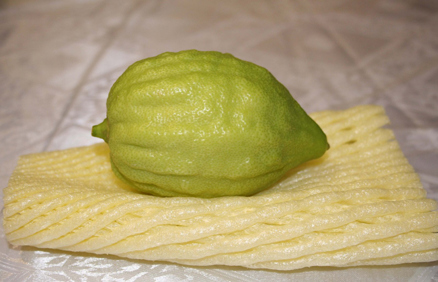Sukkot: The etrog

What is a gartel etrog? Which segulot are ascribe to eating etrog jam and why? Why can't we use a grafted etrog for the arba minim? Fun facts and important information about this ancient fruit.
A history
The etrog or citron (Citrus medica) is one of the three original species of citrus fruit. The origin of the etrog is southeast Asia (the India region), and it was known in the Land of Israel in Biblical times. In excavations in Nippur, an ancient Sumerian city in today's southeastern Iraq, etrog seeds were discovered that date back to 4000 BCE. The walls of the Karnak Temple in ancient Egypt depict etrog fruit, dated to 1450 BCE; etrog seeds were also found in Egyptian tombs.
In ancient times healing powers and sacred qualities were ascribed to the etrog in both India and Middle Eastern countries. Other citrus fruit, such as lemons, arrived in the Middle East later on.
The etrog with a waist: the gartel etrog
There is an interesting phenomenon that occurs with certain etrog varieties: on the same tree, alongside standard etrogim, grow etrogim with a ridge around the center, giving an impression that the etrog has a small waist. These are popularly known as the gartel (Yiddish for "belt") etrogim. There are several botanical hypotheses as to possible factors influencing this unique formation. Coins from the time of the Bar Kochba Revolt depict the arba minim with a gartel etrog; the mosaic floor of the synagogue in Maon (Nirim, near Netivot in southwest Israel) features gartel etrogim as well. These types of etrogim are often preferred by Hassidim, who don a gartel during their prayers to serve as a separation between their heart and the lower section of the body, and they are willing to pay top dollar for them.
Eating the etrog
We see that the etrog was commonly eaten in the times of the Mishna and Talmud. The Mishna (Sukka 4:7) tells us that on Hoshana Raba, after having performed the mitzva of taking the arba minim for the last time and beating the aravot, "מִיַּד הַתִּינוֹקוֹת שׁוֹמְטִין אֶת לוּלְבֵיהֶן וְאוֹכְלִין אֶתְרוֹגֵיהֶן" - "Immediately, the children would throw away their lulavim and eat their citrons." In the Gemara in Kiddushin (70a), R' Nachman suggests that R' Yehuda eat his etrog. In light of the above, it is clear that the etrog was the first and most prominent citrus fruit in the Middle East.
The Gemara cites certain medicinal qualities of the etrog (Shabbat 109b), saying that eating a sweet etrog filled with honey is an antidote to poisonous snake bites. The Rambam writes that "the etrog peel strengthens the heart and its seeds serve as an antidote to poisons" (Pirkei Moshe Barefu'a).
Segula for an easy childbirth
Today there is a popular segula for an easy childbirth of eating etrog jam made from etrogim used for the arba minim, especially when great rabbis made a beracha on them. This segula is ascribed to Rabbi Rachamim Nissim Yitzchak Palagi (c. 1813-1907; Izmir, Turkey), son of the renowned Rabbi Chaim Palagi. The segula is associated with the opinion that the Tree of Knowledge was an etrog tree, and after Chava ate from it she was cursed with painful childbirth. It follows that eating an etrog that was used for a mitzva and blessed (especially by great rabbis) on Sukkot, and thereafter undergoes a sweetening process to turn it into jam, serves as a rectification for Chava's sin and can help ease childbirth.
The grafted etrog
The Torah forbids grafting trees of two different species (kilei ilan). All over the world, etrog trees are grafted: either onto lemon or hushhash trees. The issue of grafted etrogim arose in the late 16th century in Europe, and the vast majority of poskim forbid using a grafted etrog as part of the arba minim (while they can be eaten).
Why can’t a grafted etrog be used for the arba minim?
The main reason is that this is a mitzva haba’a ba’aveira, a mitzva performed by means of a transgression (the Gemara cites the example of a stolen lulav), since grafting different species is a Torah prohibition.
Another approach views such etrogim as the products of two different trees (an etrog scion and a lemon rootstock), meaning that the etrog is not 100% an etrog. Note that according to current scientific studies, the fruit’s genetic makeup is only from the scion (=the etrog tree), and not from the rootstock. That is, if we plant seeds from a grafted etrog, they will grow as etrog trees for all intents and purposes, without any rootstock influences.
There are places where local farmers grow in the same orchard non-grafted etrogim for Jews and grafted etrogim for non-Jews (for candied etrogim, jams, liquor, and cosmetics).
All kashrut agencies worldwide ensure that the etrogim they certify are not grafted, so you can rest assured that etrogim with kashrut certification are not grafted.




